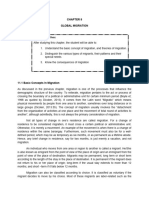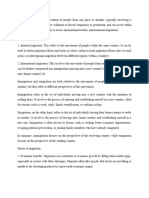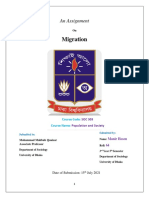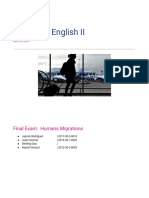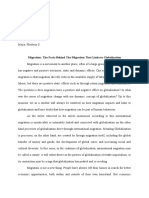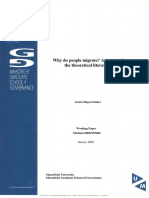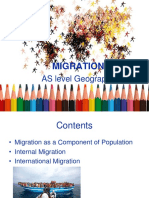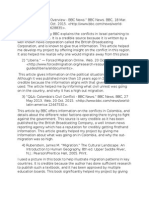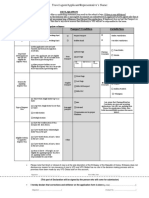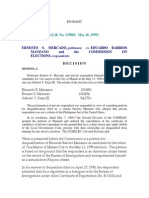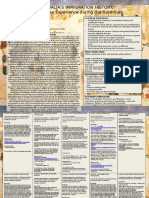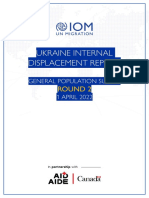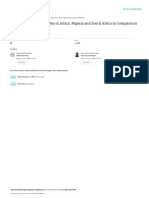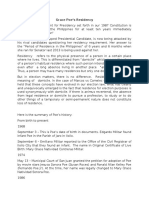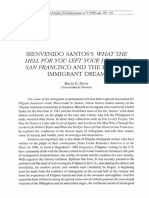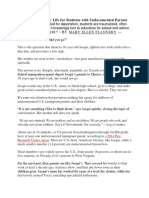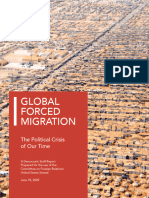Migration: Theories and Applications
Migration is defined broadly as a permanent or semi-permanent change of residence. The types of
migration include:
Internal migration. This refers to a change of residence within national boundaries, such as between states,
provinces, cities, or municipalities. An internal migrant is someone who moves to a different administrative
territory.
International migration. This refers to change of residence over national boundaries. An international
migrant is someone who moves to a different country. International migrants are further classified as legal
immigrants, illegal immigrants, and refugees. Legal immigrants are those who moved with the legal
permission of the receiver nation, illegal immigrants are those who moved without legal permission, and
refugees are those crossed an international boundary to escape persecution.
Jay Weinstein and Vijayan Pillai (2001) denote a third classification: forced migration. Forced migration
exists when a person is moved against their will (slaves), or when the move is initiated because of external
factors (natural disaster or civil war). The distinction between internal and international migration is crucial
because they happen for different reasons. Because structural barriers are more likely to impede the
mobility of a potential international migrant than an internal migrant—international migration involves
more administrative procedures, greater expense, and more difficulties associated with obtaining
employment, accessing state services, learning a new language, and the like—the motivations behind
international migration are usually stronger than those behind internal migration (Weeks 1999).
Causes of voluntary economic migration
Root Causes Proximate Causes Enabling/ Constraining Sustaining Factors
Conditions
• Economic • Unemployment Low • Financial resources • Legislation on family
restructuring income and information reunion
• Economic • Labour demand in • Travel routes • Migrant networks
mismanagement destination country • Migration control in • "Culture" of migration
• Environmental • Migration legislation in receiving country in place of origin
Degradation destination country • Migration networks
• Population Growth • Migration systems
Economic restructuring Economic Unemployment Low income Financial resources and information Legislation on
family reunion mismanagement Labour demand in Travel routes Migrant networks Environmental Degradation
Population Growth destination country Migration legislation in destination country Migration control in receiving
country Migration networks "Culture" of migration in place of origin Migration systems
Macro theories emphasise the structural, objective conditions which act as "push" and "pull" factors for migration.
In the case of economic migration, push factors would typically include economic conditions such as unemployment,
low salaries or low per capita income relative to the country of destination. Pull factors would include migration
legislation and the labour market situation in receiving countries. Involuntary displacement would be explained
through factors such as state repression or fear of generalised violence or civil war.
Most theorists agree that macro conditions such as these are crucial for explaining forced displacement and also so-
called "pioneer" voluntary migration - i.e. the first individuals or groups of migrants from a given country or area.
�However, they are less well equipped in accounting for the persistence of voluntary migration despite changes in
economic conditions or legislation in receiving countries. Nor can they explain why so much migration occurs from
relatively few places: similar push factors exist in many potential sending areas, but while in some cases they generate
mass emigration, in others there is almost no mobility.
Meso theories can help explain these discrepancies. They reject the macro focus on push and pull factors, instead
locating migration flows within a complex system of linkages between states. Two concepts are particularly
important for meso theories: systems and networks. Migration is assumed to occur within a migration system, i.e. a
group of countries linked by economic, political and cultural ties as well as migration flows.
Thus the conditions generating movement are understood as the dynamics or relations between two areas, rather
than a set of objective indicators. Networks refer to a set of individual and collective actors (actual and potential
migrants, their families, firms, religious or social groups, and so on) and the multiple social and symbolic ties that link
them together.9 Once formed, networks can substantially influence the direction and volume of migration flows,
providing resources that help people to move, such as information, contacts, economic and social support.
Micro theories focus on the factors influencing individual decisions to migrate, analysing how potential migrants
weigh up the various costs and benefits of migrating. Costs could include the financial and psychological resources
invested in moving and integrating in the country of destination, while benefits could include a higher salary or
physical safety. Micro theories often draw on rational choice theory, which makes a number of controversial
assumptions about how and why individuals take decisions.
However, the micro perspective is an important level of analysis in terms of showing how individuals internally
process and assess the various conditions generating migration. It therefore provides a form of check or control for
macro and meso theories, describing how individuals actually make decisions on the basis of objective or relational
factors.




